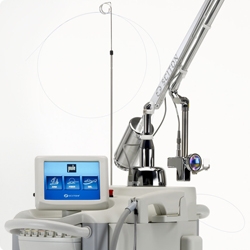
Spider veins (also called telangiectasia) are small dilated blood vessels in the surface of the skin, typically less than 1 millimeter in diameter. They can develop anywhere on the body but are commonly seen on the face and legs. Most patients with spider veins in Minnesota seek the assistance of physicians who specialize in cosmetic or vein care.
The causes of spider veins or telangiectasia in Minnesota can be divided into congenital and acquired factors. Many congenital diseases display telangiectasia. The most common acquired cause in the Minneapolis and St. Paul areas is increased venous pressure, or venous hypertension. Spider veins in the legs are often related to the presence of venous hypertension within underlying varicose veins due to valve dysfunction. Acquired telangiectasia, not related to other venous abnormalities, includes Rosacea, sun damage, radiation exposure, trauma, and topical corticosteroids.
Factors that predispose to the development of spider veins include
- Age: The risk of spider veins increases with age; spider veins usually occur in the middle age. Aging causes wear and tear on the venous valves, which can cause some blood to flow back (leak) into veins and lead to venous hypertension.
- Gender: Females are four times more likely to develop spider veins than males.
- Pregnancy: Pregnancy is an important factor contributing to the formation of varicose and spider veins.
- Lifestyle/Occupation: prolonged sitting and standing is a risk factor to develop spider veins.
- Family history: If other family members had spider veins, there’s a greater chance you will too.
- Obesity: Overweight patients have an increased chance of developing spider veins.
Sclerotherapy is the golden standard in treating large telantiectasia (spider veins). The sclerosant, such as Sotradecol is injected into the veins using tiny needles. The sclerosant then irritates the inner lining of the vein, resulting in vein closure. The vein stops carrying blood and disappears with time.
Fine Telangiectasia (spider veins) is often treated with a laser. Laser procedures deliver heat through the surface of the skin to the vein, sealing the vein walls. Side effects of laser treatments include redness/swelling and discoloration of the skin, which disappear within a few days or weeks.
Depending on the severity of the vein condition, 2 to 4 treatments with sclerotherapy and/or laser treatment may be needed. Each treatment lasts about 15 minutes.




